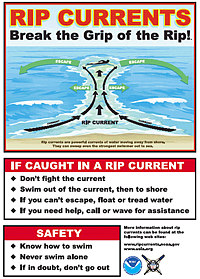|
Rip Currents: Break The Grip of the RipTM
National Weather Service and National Sea Grant Program, in partnership with the United States Lifesaving Association, are working together to raise awareness about the dangers of rip currents and how to protect yourself.
Before you go to the beach...

Rip Current poster - click to go to the download page. |
- KNOW HOW TO SWIM.
Seems simple enough, but those who do not know how to swim can be pull out to sea by a rip current and will stand little chance of survival. And just because you are in shallow water dosen't mean you are safe either. A person standing waist deep in water can be dragged out into deeper waters, where they can drown.
In April 2004, an 19-year-old man was killed by a rip current simply by standing in knee-deep ocean water. Knocked off his feet, this non-swimmer was pull out to sea and drowned.
- Check the Surf Zone Forecast for your region.
Surf Zone Forecasts will contain Rip Current Outlooks using the following, three-tiered set of qualifiers:
- Low Risk of rip currents. Wind and/or wave conditions are not expected to support the development of rip currents; however, rip currents can sometimes occur, especially in the vicinity of groins, jetties, and piers. Know how to swim and heed the advice of lifeguards.
- Moderate Risk of rip currents. Wind and/or wave conditions support stronger or more frequent rip currents. Only experienced surf swimmers should enter the water.
- High Risk of rip currents. Wind and/or wave conditions support dangerous rip currents. Rip currents are life-threatening to anyone entering the surf.
When you get to the beach...

Rip Current brochure - click to go to the download page. |
- Whenever possible, swim at a lifeguard-protected beach. Ask a lifeguard about the conditions before entering the water. This is part of their job.
- Never swim alone
- Never swim at night. Rip currents can be more dangerous at night simply because you cannot see them like you can during daylight hours.
- Stay at least 100 feet away from piers and jetties. Permanent rip currents often exist along side these structures.
- Use polarized sunglasses. They will help you to spot signatures of rip currents by cutting down glare and reflected sunlight off the ocean's surface.
- Avoid the "it won't/didn't happen to me" syndrome. Obey all instructions/orders from lifeguards and posted signs. They are there for your wellbeing.
If caught in a rip current...
- Remain calm. You will not be pulled under the surface of the water.
- Only swim parallel to the shore to escape the current. As soon as you are out of the current, only then swim toward the beach. You will not make it swimming directly against the current. It will be too strong for you.
- Another option is to just float. Eventually you will reach the end of the current. Then either...
- Swim parallel to the shore to get out of the path of the rip current and once you do so, only then swim toward the beach OR
- Draw attention to yourself by waving your arm and yelling for help (which you can do because you are not swimming alone...right?)
If you see someone in trouble...
- Throw the rip current victim something that floats--a lifejacket, a cooler, an inflatable ball.
- Get help from a lifeguard. If a lifeguard is not available, call 9-1-1.
- Yell instructions on how to escape the rip current. Tell them which way to swim.
|
|





